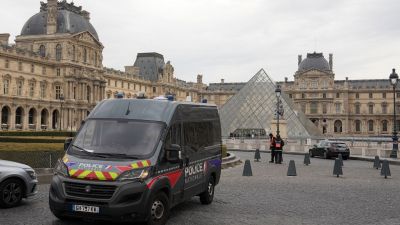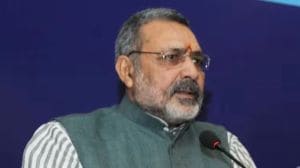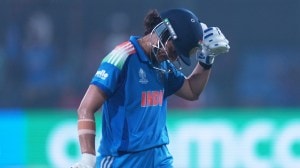Priya Kumari Shukla is a Senior Copy Editor in the Indian Express (digital). She contributes to the UPSC Section of Indian Express (digital) and started niche initiatives such as UPSC Key, UPSC Ethics Simplified, and The 360° UPSC Debate. The UPSC Key aims to assist students and aspirants in their preparation for the Civil Services and other competitive examinations. It provides valuable guidance on effective strategies for reading and comprehending newspaper content. The 360° UPSC Debate tackles a topic from all perspectives after sorting through various publications. The chosen framework for the discussion is structured in a manner that encompasses both the arguments in favour and against the topic, ensuring comprehensive coverage of many perspectives. Prior to her involvement with the Indian Express, she had affiliations with a non-governmental organisation (NGO) as well as several coaching and edutech enterprises. In her prior professional experience, she was responsible for creating and refining material in various domains, including article composition and voiceover video production. She has written in-house books on many subjects, including modern India, ancient Indian history, internal security, international relations, and the Indian economy. She has more than eight years of expertise in the field of content writing. Priya holds a Master's degree in Electronic Science from the University of Pune as well as an Executive Programme in Public Policy and Management (EPPPM) from the esteemed Indian Institute of Management Calcutta, widely recognised as one of the most prestigious business schools in India. She is also an alumni of Jamia Milia Islamia University Residential Coaching Academy (RCA). Priya has made diligent efforts to engage in research endeavours, acquiring the necessary skills to effectively examine and synthesise facts and empirical evidence prior to presenting their perspective. Priya demonstrates a strong passion for reading, particularly in the genres of classical Hindi, English, Maithili, and Marathi novels and novellas. Additionally, she possessed the distinction of being a cricket player at the national level. Qualification, Degrees / other achievements: Master's degree in Electronic Science from University of Pune and Executive Programme in Public Policy and Management (EPPPM) from Indian Institute of Management Calcutta ... Read More
UPSC Key: Selection of the Chief Election Commissioner, Geological structure of Delhi and NATO
Why India-Qatar trade relations is relevant to the UPSC exam? What is the significance of topics such as the Places of Worship Act, 1991, Faecal coliform bacteria and Sachar Committee and Ranganath Misra Commission on both the preliminary and main exams? You can learn more by reading the Indian Express UPSC Key for February 18, 2025.
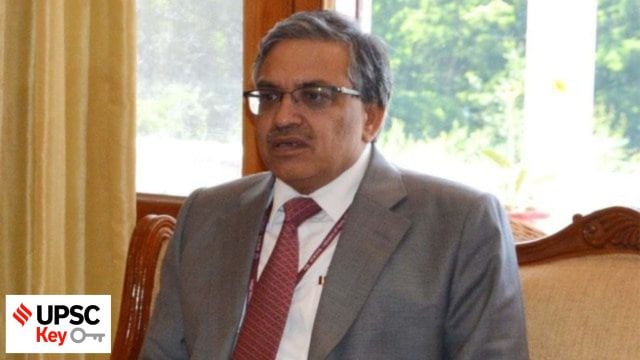 UPSC Key February, 2025: Here's what you should be reading from the February 18, 2025 edition of The Indian Express
UPSC Key February, 2025: Here's what you should be reading from the February 18, 2025 edition of The Indian Express Important topics and their relevance in UPSC CSE exam for February 18, 2025. If you missed the February 17, 2025 UPSC CSE exam key from the Indian Express, read it here
FRONT PAGE
‘RPF trying to clear overbridge when platform for Kumbh Special changed… this led to a stampede’
Syllabus:
Preliminary Examination: Current events of national and international importance.
Main Examination: General Studies III: Disaster and disaster management.
What’s the ongoing story: What set off the stampede at New Delhi Railway Station on Saturday night killing 18 people was an announcement about a change in the departure platform of a Kumbh Special train to Prayagraj, according to a report prepared by an inspector-rank officer of the Railway Protection Force (RPF).
Key Points to Ponder:
• Discuss the role of the Railway Protection Force (RPF) in ensuring crowd safety at major railway stations during mass gatherings like Kumbh Mela.
• Analyse the adequacy of India’s railway station infrastructure in handling large crowds during religious or special events.
• During major public events like Kumbh Mela, what ethical responsibilities do authorities have to ensure public safety?
• Suggest a multi-stakeholder approach involving government agencies, railway authorities, and the public to improve safety at railway stations during peak events.
• With reference to past railway stampede incidents in India, discuss the lessons learned and the policy changes introduced post-incident.
Key Takeaways:
• The inspector’s report will be taken as an input by the RPF which is preparing a final report to be submitted to the two-member high level committee set up by the Ministry of Railways.
• “…at around 8.45 pm, an announcement was made that Kumbh Special going to Prayagraj would depart from Platform Number 12, but after some time, another announcement was made that the Kumbh Special would leave from Platform Number 16, due to which a stampede situation arose among passengers,” the officer is learnt to have written in the report submitted on February 16 to his Delhi Zone seniors.
• At this time, the report said the Magadh Express was stationed at Platform 14, Uttar Sampark Kranti Express at Platform 15 and a crowd of passengers waiting to board the Prayagraj Express were also present at Platform 14 — all this froze the movement of passengers.
• “Upon hearing the announcement, passengers started trying to climb the stairs from Platforms 12-13 and 14-15 via foot-over bridges (FOBs) 2 and 3; and passengers of Magadh Express, Uttar Sampark Kranti and Prayagraj Express were climbing down the stairs. In the midst of pushing and shoving, some passengers slipped, fell on the stairs and got injured; and other passengers started walking over them,” the report said
Do You Know:
• The delay of two trains, a horde of passengers waiting on platform number 14, and an announcement for a special train – these factors, coupled with the alleged lack of management by the administration, led to the stampede at New Delhi Railway Station on Saturday evening (February 15), which left 18 dead and several injured, according to official sources.
• M Jamshed Writes in ‘Stampede at New Delhi Station should be a wake-up call for Railways’
—There are several reasons for stampedes. But a stampede in a controlled, managed and ticketed area like a railway station requires a thorough investigation and fixing of accountability. Two aspects need investigation – the overwhelming number of passengers and the crowd management measures in place.
—The unprecedented surges in numbers of passengers and those on platforms can be controlled by restricting the sale of tickets, blocking entry gates and making holding/waiting areas for passengers.
—The Railway Accident Manual is an elaborate document that defines all types of “train accidents” and “incidents”. As per the broad Railway definition, an accident is the one that necessarily involves a train. The Commissioner of Railway Safety (CRS) may hold an enquiry only in an accident of a train carrying passengers under Section 114 of the Railways Act. Therefore, even such major incidents are not under the CRS’s ambit.
—It’s time that the Railway Ministry considers amending the Act and bringing such stampede incidents within the CRS’s purview.
Other Important Articles Covering the same topic:
📍Delhi railway station stampede: Behind 10-minute chaos, delay of two trains, and an announcement
UPSC Previous Year Mains Question Covering similar theme:
📍Discuss the recent measures initiated in disaster management by the Government of India departing from the earlier reactive approach. (2020)
EC Gyanesh Kumar new poll panel chief; LoP files dissent
Syllabus:
Preliminary Examination: Current events of national and international importance.
Main Examination: General Studies II: Appointment to various Constitutional posts, powers, functions and responsibilities of various Constitutional Bodies.
What’s the ongoing story: The President on Monday appointed Election Commissioner Gyanesh Kumar as the next Chief Election Commissioner and Haryana Chief Secretary Dr Vivek Joshi as Election Commissioner.
Key Points to Ponder:
• Personality in News-Gyanesh Kumar
• What is the new selection process for the Chief Election Commissioner?
• How does the Chief Election Commissioner and Other Election Commissioners Act, 2023, elaborate the selection of the Chief Election Commissioner?
• How were the Election Commissioners appointed earlier?
• What are the challenges associated with the current appointment process of the Chief Election Commissioner?
• Examine the role of the judiciary in ensuring the independence of the Election Commission.
• Compare the selection process of the Election Commission of India with that of similar institutions in other democracies such as the USA and the UK.
Key Takeaways:
• Kumar’s appointment was announced hours after the Prime Minister-headed high-level panel met to select the new CEC to succeed Rajiv Kumar, who is set to retire on Tuesday.
• The meeting saw the Leader of the Opposition in the Lok Sabha, Rahul Gandhi, asking the government to defer the appointment until the Supreme Court decides on the petitions challenging the new appointment process. The Supreme Court is to hear the matter on Wednesday.
• Kumar was appointed to the EC on March 14, 2024, less than two months after he retired from the IAS. He assumed office on March 15 and the very next day, the Election Commission of India announced the schedule of the Lok Sabha elections.
• In the past 11 months, Kumar has been a part of the Commission, with Rajiv Kumar and fellow EC Dr Sukhbir Singh Sandhu, while it conducted the Lok Sabha polls, the first Assembly elections in the Union Territory of Jammu and Kashmir, and the Assembly elections in Haryana, Jharkhand, Maharashtra, and Delhi.
• His tenure as CEC will last till January 26, 2029, which will see him helm the Commission as it conducts 20 Assembly elections, the elections for President and Vice-President in 2027, and prepares for the 2029 Lok Sabha elections.
• An Additional Secretary in MHA from 2018 to 2021, Kumar played a pivotal role when Article 370 was abrogated in 2019 and Jammu & Kashmir was split into the two Union Territories of Ladakh and Jammu & Kashmir.
• The Narendra Modi government’s trust in Kumar as a bureaucrat is illustrated by the fact that he was not only given the responsibility of formulating the Jammu and Kashmir Reorganisation Bill, one of the most secretive Bills ever brought by a government but also that he was involved in the setting up of the Ram Janmabhoomi Teerth Kshetra Trust.
Do You Know:
• The new CEC is being appointed under a new law — Chief Election Commissioner And Other Election Commissioners (Appointment, Conditions of Service And Term of Office) Act, 2023. This law lays down procedures for appointment of both CEC and ECs.
Under the Act, a search committee headed by the Law Minister (currently Arjun Ram Meghwal) and comprising two senior bureaucrats serving as secretaries to the Government of India must first draw up a shortlist of five candidates. This shortlist is then sent to a Selection Committee made up of the Prime Minister, Leader of Opposition, and a Cabinet Minister nominated by the PM.
• The Election Commission (EC) is a three-member body made up of one Chief Election Commissioner (CEC) and two Election Commissioners. Although all three election commissioners are equal, the CEC, like the Chief Justice of India, is the first among equals. Earlier, there was no law passed by Parliament for the appointment of the CEC and ECs. The appointments were done by the President on the advice of the Prime Minister. Traditionally, the successor to the incumbent CEC has been the next senior-most Election Commissioner. Seniority was usually defined by who was appointed earlier to the Commission.
• The current Selection Committee comprises Prime Minister Narendra Modi, LoP Rahul Gandhi and Home Minister Amit Shah. This committee met Monday evening at the Prime Minister’s Office in South Block to select Rajiv Kumar’s successor. Section 8 of the Act gives this Committee the power to also consider names beyond the shortlisted five. This is the same process used to appoint Gyanesh Kumar and Sukhbir Singh Sandhu to the Commission in March 2024.
• While in the past the government had usually appointed retired senior bureaucrats to the Commission, the Act makes the qualification for the job clear: “The Chief Election Commissioner and other Election Commissioners shall be appointed from amongst persons who are holding or have held a post equivalent to the rank of Secretary to the Government of India and shall be persons of integrity, who have knowledge of and experience in management and conduct of elections,” Section 5 of the Act states.
• The Act also sets clear terms of service. “The Chief Election Commissioner and other Election Commissioners shall not be eligible for re-appointment. Where an Election Commissioner is appointed as Chief Election Commissioner, his term of office shall not be more than six years in aggregate as the Election Commissioner and the Chief Election Commissioner,” it states.
• This Act was brought after an intervention from the Supreme Court, following a clutch of petitions filed between 2015 and 2022 challenging the Centre’s exclusive powers in picking the Election Commissioners.
• The court had noted that the Constitution’s founders never intended to give the Executive exclusive appointment powers. Concerned about the “devastating effect” of leaving appointments solely to the Executive, the court established a new process. In its judgment on March 2, 2023, the Supreme Court ruled that a selection committee comprising the Prime Minister, the Leader of the Opposition in the Lok Sabha and the Chief Justice of India would select the CEC and ECs, until Parliament enacted a law.
• Before any vacancy in the Commission could arise, the government brought the Bill in Parliament, which passed it in December 2023. The Act changed the composition of the selection committee — replacing the CJI with a “Union Cabinet Minister to be nominated by the Prime Minister”, effectively giving the government the final say on who is selected.
• Association for Democratic Reforms has challenged the removal of the Chief Justice of India as member of the Selection Committee under the new law. The key constitutional question raised by these petitions is whether Parliament has the legal authority to override or modify a Constitution Bench judgment through legislation or ordinance.
Other Important Articles Covering the same topic:
📍Hearing poll cases during elections may fuel distrust, courts should avoid: CEC
📍The new CEC: Key role in reorganisation of J&K, setting up Ram Temple trust
📍Rajiv Kumar’s term as poll panel chief ends today: The hits and the misses
UPSC Previous Year Prelims Question Covering similar theme:
1. Consider the following statements: (2017)
2. The Election Commission of India is a five-member body.
3. Union Ministry of Home Affairs decides the election schedule for the conduct of both general elections and bye-elections.
4. Election Commission resolves the disputes relating to splits/mergers of recognised political parties.
Which of the statements given above is/are correct?
(a) 1 and 2 only
(b) 2 only
(c) 2 and 3 only
(d) 3 only
As Qatar Amir starts visit, trade, energy & tech ties on table
Syllabus:
Preliminary Examination: Current events of national and international importance.
Main Examination: General Studies II: Bilateral, regional and global groupings and agreements involving India and/or affecting India’s interests.
What’s the ongoing story: As the Amir of Qatar, Sheikh Tamim Bin Hamad Al-Thani, began his two-day state visit to India on Monday, Prime Minister Narendra Modi, in a special gesture, went to the airport to receive him.
Key Points to Ponder:
• Discuss the key aspects of India-Qatar trade relations.
• How does energy cooperation play a crucial role in strengthening bilateral ties between India-Qatar?
• What is the role of Indian expatriates in Qatar’s economy?
• How does Qatar’s geopolitical position in the Gulf region influence its strategic partnership with India?
• Cultural and educational exchanges between India and Qatar have been increasing in recent years. Discuss the potential for soft power diplomacy in enhancing bilateral ties.
• What are the major challenges in India-Qatar relations? Suggest measures to address them and enhance cooperation in the future.
Key Takeaways:
• “Went to the airport to welcome my brother, Amir of Qatar H.H. Sheikh Tamim Bin Hamad Al Thani. Wishing him a fruitful stay in India and looking forward to our meeting tomorrow,” Modi said on X.
• Modi and the Amir are expected to discuss India-Qatar ties related to trade, investment, energy and technology at their meeting on Tuesday. The Amir, who is on his second state visit to India after March 2015, will also meet President Droupadi Murmu.
• His visit comes at a time when negotiations are underway to end the conflict in Gaza. Qatar has played a key role in facilitating the negotiations, leading to exchange of hostages and prisoners. Doha has been the seat of Hamas’ representatives, and the Qatar royalty plays an influential role in the region’s power dynamics.
• One of the issues pending between India and Qatar is the return of a former Indian Navy personnel. In August 2022, eight former Navy personnel were arrested in Qatar on charges of espionage. They were initially handed death sentence. Following diplomatic intervention by New Delhi, the death sentence was commuted on December 28, 2023. While they were released in February 2024, and seven of the eight men have since returned to India, the last person is yet to be sent back.
• Indians form the largest expatriate community in Qatar, and are “appreciated for positive contribution in the progress and development of Qatar”, the MEA said. India-Qatar cooperation in diverse sectors has been steadily growing, aided by close ties and regular and substantive engagement, including at the highest levels of the two governments.
Do You Know:
• There has been regular exchange of high-level bilateral visits. Before the current Amir’s last state visit in March 2015, the then Amir, Sheikh Hamad bin Khalifa Al-Thani, also visited India in 1999, 2005 and 2012. Modi also paid a state visit to Doha from June 4-5, 2016.
• India’s bilateral trade with Qatar in 2022-23 was US$ 18.77 billion, with India’s exports adding up to US$ 1.96 billion and imports at US$ 16.8 billion.
• Qatar’s key exports to India include LNG, LPG, chemicals and petrochemicals, plastics and aluminium articles. India’s key exports to Qatar include cereals, copper articles, iron and steel articles, vegetables, fruits, spices, processed food products, electrical and other machinery, plastic products, construction material, textiles and garments, chemicals, precious stones and rubber.
• Qatar is the largest supplier of LNG to India (10.74 MMT for US$ 8.32 billion in FY 2022-23), accounting for over 48% of India’s global LNG imports. Qatar is also India’s largest supplier of LPG (5.33 MMT for US$ 4.04 billion in FY 2022-23) accounting for 29% of India’s total LPG imports.
• Defence cooperation forms an important pillar of the bilateral agenda. India offers training slots in its defence institutions to a number of partner countries, including Qatar. India also regularly participates in the biennial Doha International Maritime Defence Exhibition and Conference (DIMDEX) in Qatar. Indian Naval and Coast Guard ships regularly visit Qatar as part of bilateral cooperation and interaction.
• As of 2024, Indian population in Qatar forms approximately 25% of Qatar’s populace, primarily as migrant workers
Other Important Articles Covering the same topic:
📍In pictures: From Modi’s welcome to Guard of Honour at Rashtrapati Bhavan — Qatar Amir’s India visit
UPSC Prelims Practice Question Covering similar theme:
2. Qatar is a member of which of the following international organizations?
(a) OPEC (Organization of the Petroleum Exporting Countries)
(b) SAARC (South Asian Association for Regional Cooperation)
(c) GCC (Gulf Cooperation Council)
(d) Both (a) and (c)
Delhi hopes for some tariff easing as it works on US trade agreement
Syllabus:
Preliminary Examination: Current events of national and international importance.
Main Examination: General Studies II: Bilateral, regional and global groupings and agreements involving India and/or affecting India’s interests.
What’s the ongoing story: As India and the US prepare to work on the contours of a bilateral trade agreement (BTA), New Delhi hopes to secure concessions on the sweeping tariffs announced by US President Donald Trump, such as the 25 per cent tariff on all steel and aluminium, as well as reciprocal tariffs that could impact India’s exports to the US
Key Points to Ponder:
• What are the major trade disputes between India and the US?
• Analyse the impact of high US tariffs on Indian steel and aluminium exports. How can India negotiate better terms in the trade agreement?
• Discuss India’s demands for greater market access in the US. How can India leverage its strengths to secure better trade deals?
• India has been advocating for a reduction in US tariffs on Indian exports. What challenges does India face in these negotiations? Suggest possible solutions.
Key Takeaways:
• “All tariff announcements coming from the US will be addressed in the trade forum, where both countries have agreed to sign a trade deal and increase trade to $500 billion (by 2030). Negotiators from both countries will discuss a roadmap on how to move forward, including (on tariffs) being announced in the US,” a government official said in response to India’s strategy to tackle the 25 per cent tariffs on aluminium and steel.
• On reciprocal tariffs, where the US has announced plans to match high tariffs in the partner country, including India, the official said that New Delhi is awaiting clarity on its impact as the US Commerce Secretary is expected to get back with details by April 1.
• Moreover, the Senate confirmation of the United States Trade Representative (USTR), America’s top trade body, is also pending, the official added.
• However, a White House notification imposing tariffs on steel and aluminium stated that by granting exemptions to certain countries during the initial tariff implementation, the US inadvertently “created loopholes” that were exploited by China and others with excess steel and aluminium capacity, undermining the purpose of these exemptions.
• On February 11, the White House said that Argentina, Australia, Brazil, Canada, Japan, Mexico, South Korea, the European Union, Ukraine, and the United Kingdom had received exemptions, which prevented the tariffs from being effective.
Do You Know:
• Hopes for a concession during the current round of trade deal negotiations marks a shift from the past, when India had chosen to retaliate against the US on steel and aluminium tariffs imposed during Trump’s first term. This time, the White House has said that exemptions to certain countries were exploited by China and so concessions have broadly been ruled out now.
• A report from Oxford Economics last year examined the impact of the US-China trade war during Trump’s first term, highlighting that US trade rerouting was particularly pronounced in the large electronics market, where China’s share had dropped by 19 percentage points since 2017.
• India’s goods trade surplus with the US has been rising, particularly after the COVID-19 pandemic, doubling from $17.30 billion in 2019-20 to $35.33 billion in 2023-24, alongside a notable shift in the export basket.
• While exports of electronic and engineering goods surged, traditional exports such as gems & jewellery and garments remained largely unchanged.
• The most significant transformation has occurred in electronics exports, driven in part by tariffs imposed by the US during Trump’s first term.
Other Important Articles Covering the same topic:
📍Trump’s 25% tariff on steel: India fears dumping, pricing pressure
UPSC Prelims Practice Question Covering similar theme:
3. Which of the following is the primary trade-related dispute between India and the US?
(a) Intellectual Property Rights (IPR) issues
(b) Market access restrictions
(c) High tariffs on certain goods
(d) All of the above
SC flags number of pleas on Places of Worship Act: Will become impossible
Syllabus:
Preliminary Examination: Current events of national and international importance.
Main Examination:
• General Studies I: Secularism
• General Studies II: Structure, organization and functioning of the Executive and the Judiciary
What’s the ongoing story: The Supreme Court on Monday adjourned its hearing on petitions for and against the controversial Places of Worship Act, 1991, to April 2025 even as it refused to entertain fresh writ petitions in the matter.
Key Points to Ponder:
• The Places of Worship Act, 1991-Know the Key Provisions
• Under what circumstances was the Places of Worship Act, 1991 law enacted, and how did the government justify it?
• Ayodhya Ram Janmabhoomi Verdict and Section 5 of the Places of Worship Act, 1991-Connect the Dot
• What Supreme Court is saying now on the Places of Worship Act, 1991?
• How the Supreme Court’s decision to bar new petitions on the Places of Worship Act impacts judicial review and separation of powers.
• What are the key challenges in implementing the Places of Worship Act, 1991, given the ongoing disputes over religious sites in India?
• How does the Places of Worship Act contribute to communal harmony in India? Critically evaluate its effectiveness.
Key Takeaways:
• Chief Justice Sanjiv Khanna, presiding over a two-judge bench, expressed dismay over the large number of petitions being filed in the matter and said, “Somewhere we will have to stop it.”
• The Act prohibits conversion of any place of worship and provides for the maintenance of its religious character as it existed on August 15, 1947. However, the Ram Janmabhoomi-Babri Masjid issue in Ayodhya was kept out of its purview.
• Refusing to entertain further petitions, the bench – also comprising Justice Sanjay Kumar – asked those who had filed writ petitions but on which no notice was issued so far, to file intervention applications instead. “We are constrained to pass this order as there are a large number of writ petitions raising new and additional grounds etc,” it said.
• “Fresh applications except those writ petitions which are being disposed of in terms of this order will be allowed only if new grounds are raised,” the order said.
• Lawyers for the parties who have filed the fresh writs then requested that the same be treated as intervention applications instead of them having to file applications again, but the CJI said that allowing this would lead to several logistical problems. “So pending writ petitions on which notices have not been issued will be treated as disposed of in terms of this order. File an application for intervention,” he said.
• Adjourning the hearing, the CJI said the matter was to be heard by a three-judge bench but he was sitting in a two-judge combination through the day. “Relist in the week commencing April 1, 2025, before the three-judge bench,” the court directed.
Do You Know:
• On December 12, 2024, a three-judge bench of CJI Khanna and Justices Sanjay Kumar and K V Viswanathan had barred civil courts across the country from registering fresh suits challenging the ownership and title of any place of worship and from ordering surveys of disputed religious places till further orders.
• The Places of Worship Act, 1991 is “an act to prohibit conversion of any place of worship and to provide for the maintenance of the religious character of any place of worship as it existed on the 15th day of August, 1947, and for matters connected therewith or incidental thereto.”
• Section 3 of the Act bars the conversion, in full or part, of a place of worship of any religious denomination into a place of worship of a different religious denomination — or even a different segment of the same religious denomination.
• Section 4(1) declares that the religious character of a place of worship “shall continue to be the same as it existed” on August 15, 1947. Section 4(2) says any suit or legal proceeding with respect to the conversion of the religious character of any place of worship existing on August 15, 1947, pending before any court, shall abate — and no fresh suit or legal proceedings shall be instituted.
• Section 5 stipulates that the Act shall not apply to the Ramjanmabhoomi-Babri Masjid case, and to any suit, appeal or proceeding relating to it.
• The Act was brought by the then Congress government of Prime Minister P V Narasimha Rao at a time when the Ram Temple movement was at its peak. The Babri Masjid was still standing, but L K Advani’s rath yatra, his arrest in Bihar, and the firing on kar sevaks in Uttar Pradesh had raised communal tensions.
Other Important Articles Covering the same topic:
📍The Places of Worship Act must be protected
UPSC Previous Year Mains Question Covering similar theme:
📍Discuss India as a secular state and compare with the secular principles of the US constitution. (2024)
EXPRESS NETWORK
CPCB report shows high faecal levels in Prayagraj during Maha Kumbh
Syllabus:
Preliminary Examination: General issues on Environmental ecology, Bio-diversity and Climate Change – that do not require subject specialization.
Main Examination: General Studies III: Conservation, environmental pollution and degradation, environmental impact assessment
What’s the ongoing story: A new report has revealed that high levels of faecal coliform which are microbes from human and animal excreta were found in river water in which people took holy dip during Maha Kumbh in Prayagraj of Uttar Pradesh.
Key Points to Ponder:
• Faecal coliform bacteria in water are an indicator of what?
• Explain the causes and consequences of faecal coliform contamination in river water.
• How does it affect public health, especially during mass gatherings like Maha Kumbh?
• What measures should be taken by the government to ensure the safety of river water before and during religious gatherings such as the Maha Kumbh?
• Critically examine the effectiveness of the Water (Prevention and Control of Pollution) Act, 1974, in curbing river pollution in India.
Key Takeaways:
• THE National Green Tribunal was informed Monday, through a CPCB report, that various locations in Prayagraj during the ongoing Maha Kumbh were not conforming to the primary water quality for bathing with respect to the level of faecal coliform
• “River water quality was not conforming with the primary water quality for bathing with reference to Faecal Coliform [FC] at all the monitored locations on various occasions. Huge number of people taking bath at Prayagraj during Maha Kumbh Mela in river, including on auspicious bathing days, eventually led to increase in faecal concentration,” an NGT order dated February 17 quoted the CPCB report.
• A bench comprising NGT Chairperson Justice Prakash Shrivastava, Judicial Member Justice Sudhir Agarwal and Expert Member A Senthil Velwas hearing the issue of preventing sewage discharge into Ganga and Yamuna in Prayagraj. It noted the CPCB filed a report on February 3, pointing out certain violations.
• “The water quality was not conforming to the primary water quality for bathing with respect to FC…A large number of people bathe at Prayagraj…on auspicious bathing days, eventually leading to an increased faecal concentration,” the report said.
Do You Know:
• Faecal coliform (FC), a marker of sewage contamination, has a permissible limit of 2,500 units per 100 ml, according to the Central Pollution Control Board(CPCB).
• Faecal coliform (FC) bacteria, such as E.coli, are found in excreta that contaminates water through untreated sewerage. The higher the level the higher the presence of disease-causing pathogen in water.
Other Important Articles Covering the same topic:
📍Ganga’s faecal coliform level 3-12 times permissible limit in most inter-state boundaries: CPCB
UPSC Prelims Practice Question Covering similar theme:
4. Which of the following laws regulate water pollution in India?
(a) The Environment Protection Act, 1986
(b) The Water (Prevention and Control of Pollution) Act, 1974
(c) The Air (Prevention and Control of Pollution) Act, 1981
(d) Both (a) and (b)
THE IDEAS PAGE
Social justice, not just quota
Syllabus:
Preliminary Examination: Indian Polity and Governance-Constitution, Political System, Panchayati Raj, Public Policy, Rights Issues, etc.
Mains Examination:
• General Studies I: Social empowerment
• General Studies II: Welfare schemes for vulnerable sections of the population by the Centre and States and the performance of these schemes; mechanisms, laws, institutions and Bodies constituted for the protection and betterment of these vulnerable sections
What’s the ongoing story: Yogendra Yadav Writes: We need to look beyond the state and think of innovative ways to nudge NGOs, self-help groups and community charities to effectively address the needs of local Muslim communities
Key Points to Ponder:
• What is ‘Affirmative Actions’?
• What is affirmative action given in Indian Constitution?
• Analyse the socio-economic status of Muslims in India based on the findings of the Sachar Committee Report.
• Discuss the rationale behind reservations for socially and educationally backward classes in India.
• Should reservations be extended to Muslims as a community, or should alternative affirmative actions be considered?
• Compare and contrast the recommendations of the Sachar Committee and Ranganath Misra Commission regarding the upliftment of Muslims in India.
Key Takeaways:
Yogendra Yadav Writes:
• All battles for social justice turn into battles for and against quota, or quota within quota. Every group that suffers from any form of disadvantage or discrimination or just unmet need asks for reservation — ex-servicemen, sexual minorities, displaced persons. The Indian state is like a surgeon standing at the operating table with just one big knife for an instrument.
• No wonder there is a demand for reservation for the entire Muslim community. The demand gained pace ever since the Sachar Committee Report (SCR) recognised Muslims as a “socio-religious group”. Though the SCR refrained from recommending reservation for Muslims, it recorded their severe educational and economic disadvantages, the first official document to do so in a comprehensive manner.
• In 2007 the National Commission for Linguistic and Religious Minorities recommended a 15 per cent quota for minorities (10 per cent for Muslims) in jobs and education. This demand has found acceptance among many Muslim leaders and intellectuals, as the community finds itself increasingly beleaguered on multiple fronts in recent years.
• A recently released report takes us beyond this conventional frame. Authored by Hilal Ahmed, Mohd Sanjeer Alam and Nazima Parveen for the US-India Policy Institute and Centre for Development Policy and Practice, the report, ‘Rethinking Affirmative Action for Muslims in Contemporary India’, pushes this debate forward in three steps.
—First, it makes a case for why there is a need for affirmative action for Muslims.
—Second, it acknowledges that reservation for the community as a whole is not a good solution. —Third, and most importantly, it suggests a bouquet of policies to address the real and pressing disadvantages of various Muslim communities.
Do You Know:
Faizan Mustafa Writes in A brief history of religion-based reservations in India:
• The Constitution of India moved away from equality, which refers to equal treatment for all, to equity, which ensures fairness and may require differential treatment or special measures for some groups. The Supreme Court has held that equality is a dynamic concept with many aspects and dimensions, and it cannot be “cribbed, cabined and confined” within traditional and doctrinaire limits (E P Royappa vs State Of Tamil Nadu, 1973).
• The Constitution of 1949 dropped the word ‘minorities’ from Article 296 of the draft constitution (Article 335 of the present Constitution), but included Article 16(4) that enabled the state to make “any provision for …reservation…in favour of any backward class of citizens which…is not adequately represented in the services under the state”.
• The first constitutional amendment inserted Article 15(4), which empowered the state to make “any special provision for the advancement of any socially and educationally backward classes of citizens or for the Scheduled Castes and the Scheduled Tribes”.
• Article 15 specifically prohibits the state from discriminating against citizens on grounds only of both religion and caste (along with sex, race, and place of birth). After the Supreme Court’s judgment in State of Kerala vs N M Thomas (1975), reservation is considered not an exception to the equality/ non-discrimination clauses of Articles 15(1) and 16(1), but as an extension of equality.
• The Justice Rajinder Sachar Committee (2006) found that the Muslim community as a whole was almost as backward as SCs and STs, and more backward than non-Muslim OBCs. The Justice Ranganath Misra Committee (2007) suggested 15% reservation for minorities, including 10% for Muslims.
• Based on these two reports, the UPA government in 2012 issued an executive order providing 4.5% reservation of minorities — not just Muslims — within the existing OBC quota of 27%. Since the order was issued only a few days before the Assembly elections in UP, Uttarakhand, Punjab, Goa, and Manipur, the Election Commission asked the government not to implement it. The AP High Court quashed the order, and the Supreme Court refused to stay the HC’s order.
• Article 341 of the Constitution and the 1950 Presidential Order state that only Hindus are entitled to inclusion within SCs. However, Sikhs were included within SCs in 1956, and Buddhists in 1990. Muslims and Christians remain excluded. It could be argued that this too, is ‘religion-based’ reservation.
Other Important Articles Covering the same topic:
📍Reservation for Muslims: Andhra Pradesh case and issues before the court
UPSC Previous Year Prelims Question Covering similar theme:
5. In India, if a religious sect/community is given the status of a national minority, what special advantages it is entitled to? (2011)
1. It can establish and administer exclusive educational institutions.
2. The President of India automatically nominates a representative of the community to Lok Sabha.
3. It can derive benefits from the Prime Minister’s 15-Point Programme.
Which of the statements given above is/are correct?
(a) 1 only
(b) 2 and 3 only
(c) 1 and 3 only
(d) 1, 2 and 3
EXPLAINED
Syllabus:
Preliminary Examination: Indian Geography
Main Examination: General Studies I: Important Geophysical phenomena such as earthquakes, Tsunami, Volcanic activity, cyclone etc., geographical features and their location-changes in critical geographical features (including water-bodies and ice-caps) and in flora and fauna and the effects of such changes.
What’s the ongoing story: Delhi is no stranger to earthquakes, but the one that occurred before dawn on Monday was slightly different.
Key Points to Ponder:
• Discuss the key differences between earthquakes in the Delhi region and those occurring in the Himalayan region.
• How do the geological structures of the Delhi region influence seismic activities?
• Examine the role of the Indian plate and Eurasian plate collision in causing major earthquakes in North India.
• Despite being in Seismic Zone IV, Delhi continues to witness rapid urbanization with inadequate earthquake-resistant infrastructure—What are the risks and suggest measures to improve earthquake preparedness in the city?
• What are the key challenges in implementing earthquake-resistant construction in urban areas like Delhi?
• Discuss the role of policy frameworks such as the National Building Code in earthquake mitigation.
Key Takeaways:
• Mostly, the tremors experienced in Delhi from time to time are from earthquakes that originate elsewhere, sometimes as far away as Afghanistan. Monday’s magnitude 4 earthquake was located in Delhi itself, somewhere close to the Dhaula Kuan area.
• In fact, it was the strongest earthquake to have originated in Delhi in at least five years, data from the National Centre of Seismology showed.
• Another earthquake of similar magnitude occurred a couple of hours later near Siwan in Bihar. Magnitude 4 earthquakes are not very strong, and do not result in much damage. There were no reports of any damage due to Monday’s earthquakes.
Do You Know:
• Delhi lies in a seismically active area, and thus an earthquake originating here is not a surprise. In the last five years, areas in and around Delhi have produced several small earthquakes, with magnitudes ranging between 2 and 3 or lower (chart). These are barely noticed, except by seismometers.
• India’s official earthquake hazard map puts Delhi in Zone 4, the second highest classification of areas based on their susceptibility to shaking experienced during an earthquake.
• Zone 4 in India includes areas that are expected to experience MSK-8-level intensity during an earthquake. The MSK, or Medvedev-Sponheuer-Karnik scale is a measure of intensity, rather than strength, or energy released, which is described by magnitude.
• The MSK scale measures the susceptibility of an area to an earthquake. Based on the local geology and other factors, two places can feel, and be impacted by, a quake very differently, even if they are equidistant from its epicentre.
• Delhi falls in a region that has high susceptibility to quakes. MSK-8 means the area is vulnerable to major damage being caused to buildings and other infrastructure. Zone 5, the most vulnerable areas in India, correspond to MSK-9 levels of intensity or higher.

• Delhi lies in what is known as the Aravalli-Delhi Fold Belt, a seismically-active geological belt extending from southern and eastern Rajasthan to Haryana and Delhi.
• This region is characterised by the presence of deformed layers of rock that have been folded or bent due to geological processes hundreds of millions of years ago. These deformities have created stress which is sometimes released in the form of earthquakes.
• This is a very different mechanism from the one that triggers earthquakes in the Himalayan region, which is one of the most quake-prone regions in the world. The Himalayan region has been witnessing the subduction of the Indian tectonic plate under the Eurasian plate — one pushing against the other — which results in a lot of stress building up.
• The Aravalli-Delhi Fold Belt was much more seismically active in the past than it is now. Over the years, the tectonic activity in the region has slowed down considerably, leading to greater geological stability. But some faults still remain, which give rise to occasional mild earthquakes.
Other Important Articles Covering the same topic:
UPSC Prelims Practice Question Covering similar theme:
6. Which of the following is true about earthquakes in Delhi compared to those in the Himalayan region?
(a) Delhi experiences more frequent and stronger earthquakes than the Himalayas
(b) Delhi is located near a tectonic plate boundary, making it highly prone to major earthquakes
(c) Earthquakes in Delhi are mostly due to local fault movements, whereas Himalayan earthquakes result from plate collisions
(d) The seismic activity in Delhi is purely artificial and does not have any natural causes
As US position on Ukraine-NATO shifts, a recall — and why it matters
Syllabus:
Preliminary Examination: Current events of national and international importance.
Main Examination: General Studies II: Bilateral, regional and global groupings and agreements involving India and/or affecting India’s interests.
What’s the ongoing story: During his February 12 phone call with Russia’s President Vladimir Putin, US President Donald Trump rejected as “impractical” the possibility of Ukraine joining the North Atlantic Treaty Organisation (NATO), the 32-member transatlantic military alliance in which an attack on any member is considered an attack on all.
Key Points to Ponder:
• Analyse the changing position of the United States on Ukraine’s NATO membership.
• Discuss the strategic significance of Ukraine in the Russia-NATO conflict. How does Ukraine’s potential NATO membership impact global security?
• Examine how Russia’s opposition to NATO expansion has shaped the course of the Russia-Ukraine war.
• Evaluate the role of NATO in ensuring European security.
• The principle of collective defense under Article 5 of NATO has been a cornerstone of its strategy. Discuss its relevance in the context of modern conflicts such as the Russia-Ukraine war.
Key Takeaways:
• The possibility of Ukraine becoming part of NATO has been Moscow’s declared casus belli. Though the US and its European allies have never committed to when Ukraine might join the alliance, the statements by Trump and Hegseth mark a fundamental shift in America’s Ukraine policy.
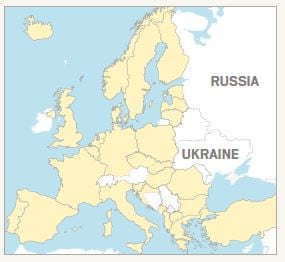 NATO member countries in Europe. (Image: The New York Times)
NATO member countries in Europe. (Image: The New York Times)
• In 1990, James Baker, President George H W Bush’s Secretary of State, assured Mikhail Gorbachev, the Soviet leader who oversaw the dissolution of the USSR, that “not an inch of NATO’s present military jurisdiction will spread in an eastern direction”, according to the transcript of the conversation preserved in the Gorbachev Foundation Archive.
• In 2000, Robert Gates, who served as CIA Director from 1991-93 and later as Secretary of Defence under Presidents George W Bush and Barack Obama, said in an interview that Gorbachev and others “were led to believe” that the West would not pursue the “expansion of NATO eastward”. (Miller Center’s George H W Bush Oral History Project)
• In 1999, less than a decade after the collapse of the USSR, NATO onboarded former Warsaw Pact countries Czechia (formerly part of Czechoslovakia), Hungary, and Poland.
• In 2004, more Warsaw Pact countries — Bulgaria, Slovakia (formerly part of Czechoslovakia) and Romania — joined NATO, as did erstwhile Soviet republics Estonia, Latvia, and Lithuania, and Slovenia, which was formerly a part of neutral Yugoslavia. NATO was now literally at Russia’s doorstep.
• Albania and Croatia joined in 2009, and Montenegro and North Macedonia in 2017 and 2020 respectively, expanding NATO’s Eastern European footprint further.
Do You Know:
• Article 5 in the NATO Charter of 1949 establishes the principle of collective defence, such that “an armed attack” against any NATO member is to be considered as “an attack against them all”, and all NATO members would be obligated to defend the one who has been attacked.
• The expansion of NATO presents Russia with a classic “security dilemma”, a situation in which the actions of one state to make itself more secure tends to make another state less secure, and prompts them to respond in ways that result in a spiral of hostility.
• Putin’s Russia sees NATO as a tool of Western hegemony, and its expansion eastward appears as the US creeping up on its Cold War enemy, which Moscow perceives as a threat to its national security.
Other Important Articles Covering the same topic:
📍NATO at 75: Why the alliance was formed, where it stands today
UPSC Previous Year Prelims Question Covering similar theme:
7. Which of the following countries joined NATO most recently?
(a) Finland
(b) Poland
(c) Ukraine
(d) Sweden
|
PRELIMS ANSWER KEY |
| 1. (d) 2. (c) 3. (d) 4.(d) 5.(c) 6.(c) 7.(a) |
For any queries and feedback, contact priya.shukla@indianexpress.com
Subscribe to our UPSC newsletter. Stay updated with the latest UPSC articles by joining our Telegram channel – IndianExpress UPSC Hub, and follow us on Instagram and X.
UPSC Magazine
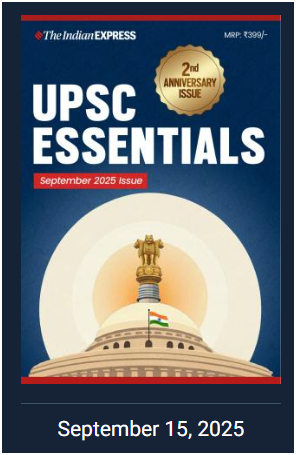
Read UPSC Magazine





- 01
- 02
- 03
- 04
- 05



